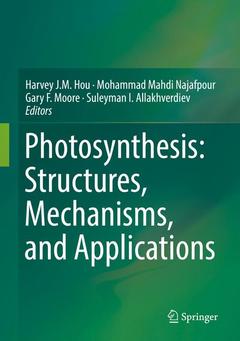Photosynthesis: Structures, Mechanisms, and Applications, Softcover reprint of the original 1st ed. 2017
Coordonnateurs : Hou Harvey J.M., Najafpour Mohammad Mahdi, Moore Gary F., Allakhverdiev Suleyman I.

Harvey J.M. Hou, born in 1962 in China, is a Professor in the Department of Physical Sciences at Alabama State University, Montgomery, Alabama, USA. He received his B.Sc. in Physical Chemistry in 1984 from Wuhan University, and completed his Ph.D. in Analytical Chemistry in 1993 at Peking University (Beijing, China) with Xiaoxia Gao. He had his postdoctoral training at Chinese Academy of Sciences with Peisung Tang and Tingyun Kuang, at Iowa State University with Parag Chitnis, and at the Rockefeller University with David Mauzerall. Since 1995, he has served as a faculty member at the Chinese Academy of Sciences, Gonzaga University, the University of Massachusetts at Dartmouth, and the Alabama State University. He began his research career in photosynthesis in 1993, working on photosystem II (PS II). In 1996, he visited the laboratory of Jacque Breton in France and studied the orientation of pigments in PS II. In the laboratory of Parag Chitnis, he examined the organization of PS I. Working with David Mauzerall, he systematically investigated the thermodynamics of electron transfer reactions in photosynthesis using pulsed photoacoustics. His work has uncovered a significant entropy change of reaction in PS I; further, he has demonstrated that the entropy change in PS I is dramatically different from that in PS II. Since he established his laboratory in 2002, he has maintained his long-term collaboration with David Mauzerall on the thermodynamics in cyanobacterial PS I and in Heliobacteria. In 2006, he began collaboration with Gary Brudvig at Yale University and Dunwei Wang at Boston College on artificial photosynthesis, and has developed a manganese/semiconductor system for solar energy storage. His research group has also investigated the responses of cyanobacteria and cranberry plants to environment. He co-chaired a symposium at the 15th International Congress of Photosynthesis Research, chaired the 28th Annual Eastern Regional Photosynthesis Confere
Covers several very new topics on photosynthesis, all under one volume
Describes recent structures and mechanisms of natural photosynthetic systems including light-harvesting complexes as well as type-I and type-II reaction centers
Includes detailed structures and mechanisms of artificial photosynthetic systems
Date de parution : 05-2017
Ouvrage de 417 p.
17.8x25.4 cm
Disponible chez l'éditeur (délai d'approvisionnement : 15 jours).
Prix indicatif 232,09 €
Ajouter au panierDate de parution : 07-2018
Ouvrage de 417 p.
17.8x25.4 cm
Disponible chez l'éditeur (délai d'approvisionnement : 15 jours).
Prix indicatif 232,09 €
Ajouter au panier